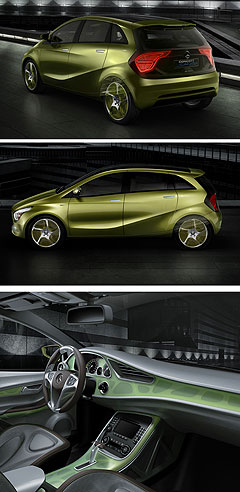Future models - Mercedes-Benz - A-classFirst look: BlueZero brings new B from BenzZero-hour: Redesigned version of Mercedes' popular B-class will be further differentiated from the next-generation A-class. Next Benz baby previewed BlueZero concept combines "fascination and responsibility"18 Dec 2008 MERCEDES-BENZ will present a trio of concept cars at next month’s North American International Auto Show in Detroit that indicate what the next generation B-class will look like when it arrives in local showrooms some time around 2011. Although the Concept BlueZero is being presented in various environmental guises – electric, hydrogen and petrol-electric hybrid – the German car-maker has confirmed its B-class status by describing it as “near-series”. According to Mercedes-Benz, all three drivetrains employ the latest development of liquid-cooled lithium-ion batteries to provide optimum power output and recharging times. The so-called E-Cell version of the car, which is a plug-in electric car with reportedly 100kW of power and 320Nm of torque on tap, has a range of almost 200km after a two-hour recharge. Mercedes-Benz claims the car – along with the other two concepts – will accelerate from 0-100km/h in less than 11 seconds, but the top speed is electronically-limited to just 150km/h in the interests of optimal range and energy efficiency. Employing a hydrogen fuel cell stack is the second concept, called the BlueZero F-Cell, has a range of 400km.  The slightly more conventional hybrid BlueZero model is called the E-Cell Plus because it uses the compact 1.0-litre engine from the Smart ForTwo city car as an additional “range-extender”, allowing a range of well over 600km on a tank of petrol in addition to the electric-only mode. The slightly more conventional hybrid BlueZero model is called the E-Cell Plus because it uses the compact 1.0-litre engine from the Smart ForTwo city car as an additional “range-extender”, allowing a range of well over 600km on a tank of petrol in addition to the electric-only mode.Running at a constant 3500rpm, the turbocharged three-cylinder petrol engine – which is located at the rear of the vehicle – produces 50kW of power to recharge the 17.5kWh lithium-ion battery by means of a similarly-rated alternator. Both of the E-Cell models can store enough energy for a range of 50km with a 30-minute charge and incorporate an electronic control unit that supports intelligent charging stations and billing systems. Showing the way to the next production B-class, the platform of the concept car continues to utilise the unusual sandwich-floor architecture that Mercedes-Benz introduced some 10 years ago, first with the baby A-class and then with the larger B-class. Mercedes-Benz Cars research and development chief Thomas Weber said the modular system allows a wide range of different drive configurations. “The modified sandwich-floor platform provides the perfect basis for a wide model range with electric drive systems,” said Dr Weber. “We are also developing a new, additional platform for future compact models with power units based on optimised internal combustion engines. The intelligent networking of both architectures enables us to develop our product portfolio extremely flexibly and efficiently. “From 2009, we will be producing the first Mercedes fuel-cell cars on a small scale. Small-scale production of Mercedes-Benz cars with battery-electric drive alone will then commence in 2010.” In terms of styling, the concept car incorporates what looks suspiciously like BMW’s controversial flame-surfacing design language along its flanks, although Benz design chief Gorden Wagener prefers to describe it as incorporating the company’s “guiding principle” of ‘Fascination and Responsibility’. A-class pricing
Motor industry news |
Click to shareMercedes-Benz modelsResearch Mercedes-Benz A-class pricing
Motor industry news |














Facebook Twitter Instagram